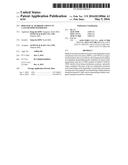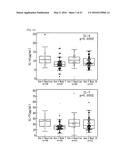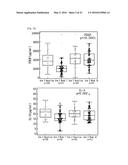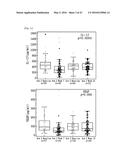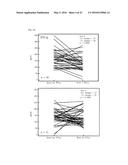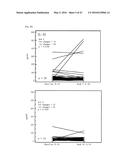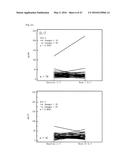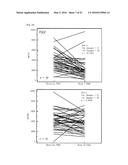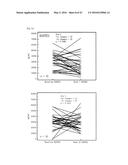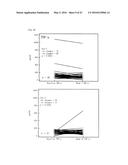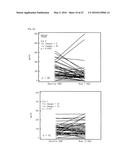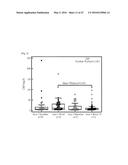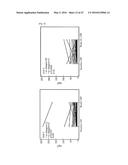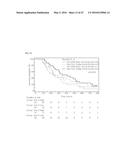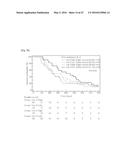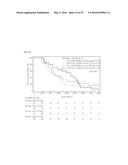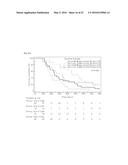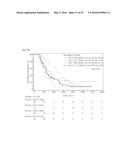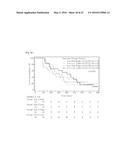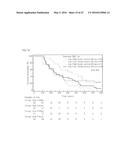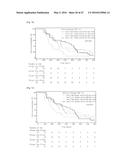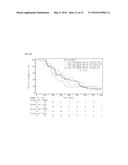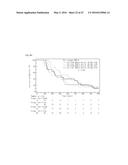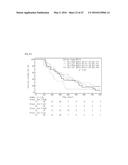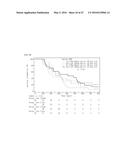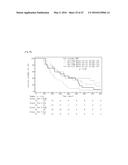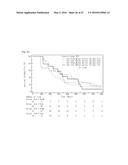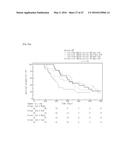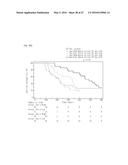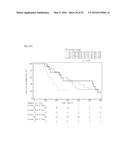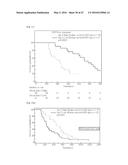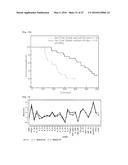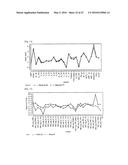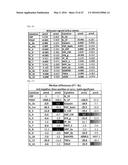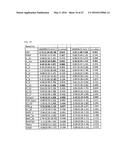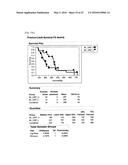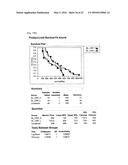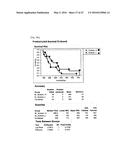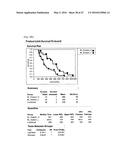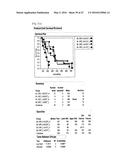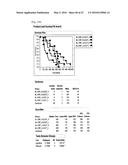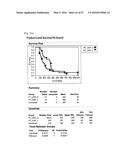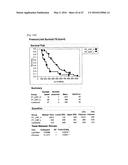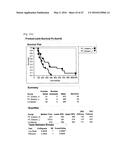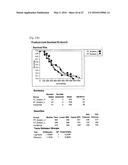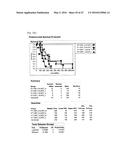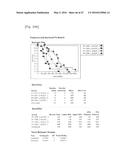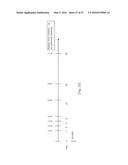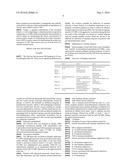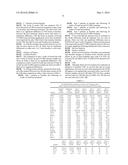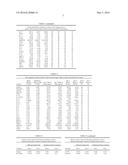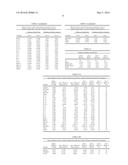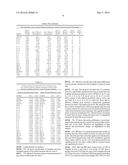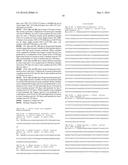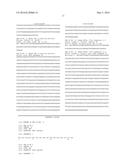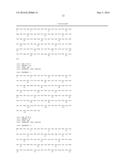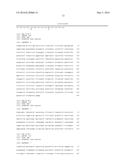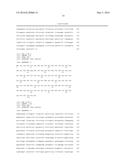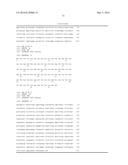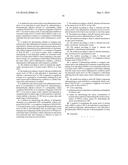Patent application title: BIOLOGICAL MARKERS USEFUL IN CANCER IMMUNOTHERAPY
Inventors:
Sang-Jae Kim (Seoul, KR)
Sang-Jae Kim (Seoul, KR)
Sang Jae Kim (Gangnam, Seoul, KR)
Assignees:
GEMVAX & KAEL CO., LTD.
IPC8 Class: AA61K3900FI
USPC Class:
4241851
Class name: Drug, bio-affecting and body treating compositions antigen, epitope, or other immunospecific immunoeffector (e.g., immunospecific vaccine, immunospecific stimulator of cell-mediated immunity, immunospecific tolerogen, immunospecific immunosuppressor, etc.) amino acid sequence disclosed in whole or in part; or conjugate, complex, or fusion protein or fusion polypeptide including the same
Publication date: 2016-05-05
Patent application number: 20160120966
Abstract:
Methods are disclosed that are based on the finding that serum and plasma
levels of eotaxin, MIP1α, and CRP act as important biomarkers that
are useful for determining the feasibility in instigating
immunotherapeutic treatment of cancer when immunizing with the GV1001
peptide (EARPALLTSRLRFIPK; derived from human telomerase protein),
optionally when combined with state of the art combination treatment with
Gemcitabine and Capecitabine. In particular, the present invention
provides methods for determining whether patients should be treated
GV1001 and for determining whether instigated treatment should be
continued.Claims:
1. A method for anti-cancer and/or anti-inflammatory treatment of an
individual in need thereof by administering a therapeutically effective
amount of a polypeptide, which comprises SEQ ID NO: 1 or comprises a
fragment of SEQ ID NO: 1 of at least 8 amino acids, if said individual
exhibits an increased serum level of eotaxin and/or MIP1.alpha. when
compared to population average or to a population of individuals
suffering from the same cancer and/or inflammatory condition.
2. A method for determining whether to instigate anti-cancer and/or anti-inflammatory treatment of an individual in need thereof, wherein said anti-cancer treatment and/or anti-inflammatory treatment involves administration of a polypeptide, which comprises SEQ ID NO: 1 or comprises a fragment of SEQ ID NO: 1 of at least 8 amino acids, comprising determining if said individual exhibits an increased serum level of eotaxin and/or MIP1.alpha. when comparing to the population average or to a population of individuals suffering from the same cancer and/or inflammatory condition, a positive determination indicating that said treatment is justified.
3. The method according to claim 2, wherein the significantly increased level of eotaxin and/or MIP1.alpha. is at least 10%.
4. The method according to claim 2, wherein in addition the serum level of CRP in said individual is determined, and wherein a decreased level of CRP compared to population average or to a population of individuals suffering from the same cancer and/or inflammatory condition is a further indication that said treatment is justified.
5. A method for anti-cancer and/or anti-inflammatory treatment of an individual in need thereof by administering a therapeutically effective amount of a polypeptide, which comprises SEQ ID NO: 1 or comprises a fragment of SEQ ID NO: 1 of at least 8 amino acids, wherein said treatment is continued after an initial stage of said treatment if said individual exhibits a decrease of CRP level in serum after said initial stage of said treatment.
6. A method for determining the efficacy of therapeutic treatment of an individual with a polypeptide, which comprises SEQ ID NO: 1 or comprises a fragment of SEQ ID NO: 1 of at least 8 amino acids, comprising determining the serum level of CRP in said individual after an initial stage of said treatment and comparing with the serum level of CRP prior to said initial stage of treatment, where a decrease in said serum level indicates that said treatment is effective in terms of conferring an increase in survival time.
7. The method according to claim 5, wherein said decrease in the serum level of CRP is at least 10%.
8. The method according to claim 1, wherein said anti-cancer and/or anti-inflammatory treatment involves concurrent treatment with at least one cytostatic or cytotoxic agent.
9. The method according to claim 8, wherein said concurrent treatment involves administration of GemCap.
10. The method according to claim 1, wherein treatment is an anti-cancer treatment.
11. The method according to claim 1, wherein the treatment is treatment of pancreatic cancer.
12. The method according to claim 1, wherein said polypeptide is administered parenterally.
13. The method according to claim 2, wherein determination of serum levels is performed in vitro.
14. The method according to claim 1, wherein said polypeptide consists of SEQ ID NO: 1 or a fragment of at least 8 amino acids of SEQ ID NO: 1.
15. A method of determining whether to instigate anti-cancer and/or anti inflammatory treatment comprising determining if an individual exhibits (a) an increased serum level of eotaxin and/or MIP1.alpha. compared to individuals suffering from the same cancer and/or inflammatory condition and/or (b) decreased serum level of CRP compared to individuals suffering from the same cancer and/or inflammatory condition.
16. The method according to claim 15, further comprising administering to said individual a polypeptide which comprises SEQ ID NO: 1 or comprises a fragment of at least 8 amino acids of SEQ ID NO: 1.
17. A kit comprising a) a pharmaceutical composition comprising a polypeptide of claim 1, and b) means for determining the serum concentration of eotaxin and/or means for determining the serum concentration of MIP1.alpha. and/or means for determining the serum concentration of CRP.
18. A method of modulating the serum level of eotaxin and/or MIP1.alpha. and/or CRP in an individual in need thereof, said method comprising, administering to said individual a therapeutically effective amount of the polypeptide of claim 1.
19. (canceled)
Description:
TECHNICAL FIELD
[0001] The present invention relates to the field of cancer immunotherapy and the field of anti-inflammatory drugs. In particular the present invention relates to methods and kits for use in therapy, where the diagnostic/predictive value of eotaxin and C-reactive protein are exploited.
BACKGROUND ART
[0002] The 16-mer peptide EARPALLTSRLRFIPK (SEQ ID NO: 1; also termed "GV1001") is a fragment of the human telomerase enzyme (WO 00/02581). GV1001 binds multiple HLA class II molecules and harbours putative HLA class I epitopes. The peptide has therefore been considered capable of eliciting combined CD4/CD8 T-cell responses, which in turn are important for initiation of tumour eradication and long-term memory. Clinical trials in advanced pancreatic and pulmonary cancer patients have demonstrated GV1001-specific T-cell responses in >50% of subjects, without clinically important toxicity (Kyte JA (2009), Expert Opin Investig Drugs 18 (5):687-94.
[0003] An on-line publication on chronic inflammation by the Life Extension foundation (www.lef.org; accessed 6 Jun. 2013), focused on the long-term health effects of chronic, low-level inflammation, reviewed various markers and mediators of inflammation, among which tumour necrosis factor alpha (TNFα), nuclear factor kappa-B(NF-κB), interleukins, C-reactive protein (CRP), eicosanoids, cyclooxygenases (COX) and lipooxygenases (LOX) and various other inciting factors.
[0004] Guo et al. (J Immunol 2001; 166:5208-5218) found that eotaxin mRNA and protein were upregulated during an inflammatory response in a rat model of acute inflammatory injury, and explored its role in neutrophile recruitment.
[0005] Eotaxin-1, -2 and -3 (also known as CCL11, CCL24 and CCL26) are known chemokines known to recruit eosinophils and other leukocytes, and elicit their effects by binding to the cell surface chemokine receptors (e.g., CCR3).
DISCLOSURE OF INVENTION
Technical Problem
[0006] It is an object of embodiments of the invention to provide improved methods for predicting efficacy of medical treatment with GV1001-derived drugs as well as for predicting patient survival among individuals suffering from cancer, in particular pancreatic cancer.
Solution to Problem
[0007] TeloVac, a multi-centre Phase III trial of a GV1001 based vaccine in advanced and metastatic pancreatic cancer has recently been conducted through the Cancer Research UK Liverpool Clinical Trials Unit and supported by the GemVax AS, a subsidiary of KAEL-GemVax.
[0008] The trial recruited 1062 patients in 52 centres throughout the United Kingdom. While there was no significant difference in overall survival between the groups that received the vaccine and the control group receiving chemotherapy, the trial however also included an ambitious program of translational research. Initial results indicate that the vaccine resulted in a significant anti-inflammatory response that correlates well with new research being conducted by the parent company, Kael-GemVax. Additionally, 3 possible biomarkers--eotaxin, MIP1α, and CRP--were identified in a subgroup of patients as indicators of an increased survival.
Advantageous Effects of Invention
[0009] So, in its broadest aspects, the invention relates to the use of eotaxin and/or MIP1α and/or CRP as prognostic tools useful in therapeutic treatment with GV1001-derived material.
BRIEF DESCRIPTION OF DRAWINGS
[0010] FIG. 1: Graphs showing levels of IL-4, IL-5, IL-7, IL-17, PDGF and VEGF in serum form baseline arm 2 and 3, arm 2 week 7 and arm 3 week 10 patients (p values uncorrected Kruskal-Wallis).
[0011] FIG. 2: Graphs showing the change in levels of IFNγ, IL-10, IL-7, PDGF, RANTES, TNFα and VEGF for arms 2 and 3. Also shown are the numbers of positive (+ve) and negative (-ve) changes along with p values.
[0012] FIG. 3: Levels of CRP in arm 2 and 3 patients at baseline and following treatment.
[0013] FIG. 4: Paired analysis of CRP in arm 2 patients (left) and 3 patients (right) at baseline and following treatment Also shown are the numbers of positive (+ve) and negative (-ve) changes along with p values.
[0014] FIG. 5: Survival curves for IL-8 dichotomised at the median for baseline levels, post treatment levels and absolute change form baseline to post treatment.
[0015] FIG. 6: Survival curves for Eotaxin dichotomised at the median for baseline levels, post treatment levels and absolute change form baseline to post treatment.
[0016] FIG. 7: Survival curves for MIP1α dichotomised at the median for baseline levels, post treatment levels and absolute change form baseline to post treatment.
[0017] FIG. 8: Survival curves for MIP1β dichotomised at the median for baseline levels, post treatment levels and absolute change form baseline to post treatment.
[0018] FIG. 9: Survival curves for VEGF dichotomised at the median for baseline levels, post treatment levels and absolute change form baseline to post treatment.
[0019] FIG. 10: Survival curves for CRP dichotomised at the median for baseline levels, post treatment levels and absolute change form baseline to post treatment.
[0020] FIG. 11. Survival curves for CRP dichotomised at the median for post treatment levels in arm 3.
[0021] FIG. 12: (A) Survival curves for eotaxin (high: median survival 493 days, n=16; low:median survival 239 days, n=25). (B) Survival curves for CRP (high: median survival 222 days, n=20; low: median survival 486 days, n=21).
[0022] FIG. 13 shows profile plots of baseline and post-treatment means of log cytokine data from serum for Arm 2. BL and PT represent baseline and post treatment, respectively.
[0023] FIG. 14 shows baseline and post treatment means of log cytokine data from serum for Arm 3.
[0024] FIG. 15 shows a profile plot of the mean differences (post-treatment-baseline) for the cytokines in serum for each arm. Of note, 19 cytokines showed a statistically significant decrease between baseline and post-treatment in Arm 2 (PDGF, IL1β, IL-1ra, IL-2, IL-4, IL-5, IL-7, IL-10, IL-12, IL-13, IL-17, GCSF, IFNγ, eotaxin, FGFb, MIP1β, RANTES, TNFα, VEGF; but not CRP, IL-6, IL-8, IL-9, IL-15, GM-CSF, IP10, MCP1, MIP1α) and none in Arm3.
[0025] FIG. 16 shows the p-values obtained from a Wilcoxon signed-rank test used on each cytokine form serum for each arm to test for increase/decrease in values from baseline to post treatment. The significant differences (p<0.05) as seen are in bold grey font. The decreases were larger in Arm2 than in Arm3, noting that there were 19 significant decreases in Arm2 but none in Arm3.
[0026] FIG. 17 shows the median difference of post-treatment minus baseline levels, for each cytokine in serum, for each arm of the study. Decreases are highlighted in light shadow and increases/no change are highlighted in dark shadow.
[0027] FIG. 18 shows Cox proportional hazards models on baseline data for each cytokine in serum for each arm of the study. The table gives univariate analyses for the baseline data and shows hazard ratios with 95% confidence intervals and p-values. CRP, IL-1ra, IL-2, IL-10, Eotaxin and IFNγ are significant (p<0.1) for Arm 2, while CRP, IL-1ra and Eotaxin are significant for Arm 3.
[0028] FIG. 19a and FIG. 19b show levels of CRP at baseline in Arm 2 and Arm 3. Low levels of CRP gave a median survival of 337 days for Arm 2 and a median survival of 373 days for Arm 3. Baseline CRP levels predicted median (95% CI) overall survival in Arm3 (high CRP=250 [132-451] days; low CRP=372.5 [229-517] days; p=0.0500) but not in Arm2 (high CRP=195 [140-262] days; low CRP=337 [167-366] days; p=0.2534)
[0029] FIG. 20a and FIG. 20b show levels of Eotaxin at baseline in Arm 2 and Arm 3. High levels of Eotaxin in serum give a median survival of 300 days for Arm 2 and a median survival of 451 days for Arm 3. Baseline eotaxin levels predicted median (95% CI) overall survival in Arm3 (high eotaxin=451 [308-623] days; low eotaxin=238.5 [178-344] days; p=0.0135) but not in Arm2 (high eotaxin=299.5 [167-358] days; low eotaxin=188 [102-320] days; p=0.1138)
[0030] FIG. 21a and FIG. 21b show Proportional hazards models using dichotomized variables for the baseline data for CRP and Eotaxin in serum combined. When variables were combined at baseline the longest overall survival was predicted by a combination of low levels of CRP plus high levels of Eotaxin in Arm 2 (median survival=337 days) and similarly for Arm 3 (median survival=450 days).
[0031] FIG. 22a and FIG. 22b show CRP in serum post treatment in Arm 2 and Arm 3. Low levels of CRP give a median survival of 337 days for Arm 2 and a median survival of 450 days for Arm 3.
[0032] FIG. 23a and FIG. 23b show Eotaxin in serum post treatment in Arm 2 and Arm 3. High levels of Eotaxin give a median survival of 251 days for Arm 2 and a median survival of 364 days for Arm 3.
[0033] FIGS. 24a and 24b show Proportional hazards models using dichotomized variables for the post-treatment data for serum CRP and serum Eotaxin combined. When variables were combined the longest survival was predicted by a combination of low levels of CRP plus high levels of Eotaxin in Arm 2 (median survival=355 days) and similarly for Arm 3 (median survival=535 days). When variables were combined at post-treatment the longest survival was predicted by a combination of low levels of CRP plus high levels of Eotaxin in Arm 2 (median survival=355 days) and similarly for Arm 3 (median survival=535 days).
[0034] FIG. 25 shows the vaccination schedule employed in the Examples.
BEST MODE FOR CARRYING OUT THE INVENTION
Definitions
[0035] "GV1001" denotes the telomerase-derived peptide having SEQ ID NO: 1: EARPALLTSRLRFIPK
[0036] "Eotaxin" denotes the protein having any one of the amino acid sequences SEQ ID NO: 2-4 (or allelic or naturally occurring isoforms or variants thereof), which can be encoded by any one of the nucleic acid sequences SEQ ID NO: 5-7, respectively.
[0037] "CRP" is the protein having the amino acid sequence SEQ ID NO: 8 (or allelic or other naturally occurring isoforms or variants thereof), which can be encoded by the nucleic acid sequence SEQ ID NO: 9.
[0038] "MIP1α" is the protein having the amino acid sequence SEQ ID NO: 10 (or allelic or other naturally occurring isoforms or variants thereof), which can be encoded by the nucleic acid sequence SEQ ID NO: 11.
Specific Embodiments of the Invention
[0039] In one embodiment, the present invention provides a method for anti-cancer and/or anti-inflammatory treatment of an individual in need thereof by administering a therapeutically effective amount of a polypeptide, which comprises SEQ ID NO: 1 or comprises a fragment of SEQ ID NO: 1 of at least 8 amino acids (such as 8, 9, 10, 11, 12, 13, 14 or 15 amino acids), if said individual exhibits an increased serum level of eotaxin and/or MIP1α when compared to population average or to a population of individuals suffering from the same cancer and/or inflammatory condition.
[0040] A related embodiment relates to a method for determining whether to instigate anti-cancer and/or anti-inflammatory treatment of an individual in need thereof, wherein said anti-cancer treatment and/or anti-inflammatory treatment involves administration of a polypeptide, which comprises SEQ ID NO: 1 or comprises a fragment of SEQ ID NO: 1 of at least 8 amino acids, comprising determining if said individual exhibits an increased serum level of eotaxin and/or MIP1α when comparing to the population average or to a population of individuals suffering from the same cancer and/or inflammatory condition, a positive determination indicating that said treatment is justified.
[0041] As appears from the examples, it has been found by the present inventors that median survival of cancer patients receiving the medical treatments disclosed herein is at its highest when these patients exhibit a combined baseline serum level of high eotaxin and low CRP. Further, it is also found that patients that exhibit the same combination (high eotaxin, low CRP) post-treatment art those that have the highest median survival.
[0042] Hence according to the present invention, the treatments of the present invention are preferably those where the patients subjected to the treatments are those who prior to treatment exhibit increased eotaxin and/or MIP-1α serum levels in combination with decreased CRP levels--again the levels are determined either relative to the average (or median) in the general population or relative to the average or median in the relevant patient group.
[0043] Depending on the exact route of administration, the effective amount administered according to the various embodiments of the invention may vary. If the polypeptide is administered as a vaccine, the amounts typically range from 0.5 μg up to 500 mg, with preferred administration amounts ranging between 10 μg to 1000 μg, and in particular between 20 and 200 μg. These ranges are also relevant when the polypeptide is administered as an anti-inflammatory agent, but it may be relevant--for instance if the polypepide is administered intraveneously or intraarterially--to regulate the amounts administered on the basis of the individual's condition, body weight and age.
[0044] Increased levels of eotaxin and/or MIP1α and/or CRP are in the relevant embodiments determined according to standardized assays generally known in the art-immune assays, for instance ELISAs, are preferred, but also assays that determine the activity of these cytokines on suitable target cells or suitable target molecules are relevant. If an assay is very sensitive and accurate, even small increases compared to standard values may be relevant, whereas less sensitive or accurate assays will require that larger deviations from standard values can be determined. As a rule, for a given assay for a particular cytokine there will exist a range of normal values and if the cytokine level is beyond these normal values, the level of eotaxin or MIP1α will be considered to be increased. Typically, the increased baseline level of eotaxin and/or MIP1α is at least 10%, but higher increases in values may be relevant: at least 15%, at least 20%, at least 30%, at least 40%, at least 50%, at least 60%, at least 70%, at least 80%, and even at least 100%.
[0045] Another embodiment of the invention relates to a method for anti-cancer and/or anti-inflammatory treatment of an individual in need thereof by administering a therapeutically effective amount of a polypeptide, which comprises SEQ ID NO: 1 or comprises a fragment of SEQ ID NO: 1 of at least 8 amino acids, wherein said treatment is continued after an initial stage of said treatment if said individual exhibits a decrease of CRP level in serum after said initial stage of said treatment. This is to mean, that the treatment has been instigated, but subsequently the measurement of CRP is used to gauge the efficacy of the treatment regimen. If serum CRP does not decrease or increases (cf. the remarks concerning assay sensitivity above), the findings of the present invention questions whether continued treatment with the GV1001-derived polypeptide is of value to the patient, meaning that it can be considered to terminate this part of the treatment and turn to possible alternatives or palliative treatment.
[0046] Related to this embodiment is a method for determining the efficacy of therapeutic treatment of an individual with a polypeptide, which comprises SEQ ID NO: 1 or comprises a fragment of SEQ ID NO: 1 of at least 8 amino acids, comprising determining the serum level of CRP in said individual after an initial stage of said treatment and comparing with the serum level of CRP prior to said initial stage of treatment, where a decrease in said serum level indicates that said treatment is effective in terms of conferring an increase in survival time.
[0047] Said decrease in the serum level of CRP should typically be at least 10%, but further decreases in values may be relevant: at least 15%, at least 20%, at least 30%, at least 40%, at least 50%, at least 60%, at least 70%, and even at least 80%.
[0048] The above-described embodiments have focussed on the use of the GV1001-derived polypeptide, but in important embodiments of the invention, the anti-cancer and/or anti-inflammatory treatment involves concurrent treatment with at least one cytostatic or cytotoxic agent. For instance, the concurrent treatment may involve administration of GemCap as in the present examples, but depending on the cancer or inflammatory disease in question, the GV1001-derived peptide may according to the present invention be combined with the administration of cytostatic/cytotoxic agents particular relevant for the treatment of the disease in question.
[0049] Very important embodiments of the invention are those where the treatment is an anti-cancer treatment, and particularly preferred is treatment of pancreatic cancer. However, treatment of other cancer forms are contemplated, and the cancer may be selected from the group consisting of an epithelial cancer, a non-epithelial cancer, and a mixed cancer. The epithelial cancer may be both a carcinoma or an adenocarcinoma, and the non-epithelial or mixed cancer is typically a liposarcoma, a fibrosarcoma, a chondrosarcoma, an osteosarcoma, a leiomyosarcoma, a rhabomyosarcoma, a glioma, a neuroblastoma, a medullablastoma, a malignant melanoma, a malignant meningioma, a neurofibrosarcoma, a leukemia, a myeloproleferative disorder, a lymphoma, a he-mangiosarcoma, a Kaposi's sarcoma, a malignant teratoma, a dysgerminoma, a seminoma, or a choriosarcoma.
[0050] Also, the anatomic location of the cancer can be anywhere in body. So the cancer may be a of the eye, the nose, the mouth, the tongue, the pharynx, the oesophagus, the stomach, the colon, the rectum, the bladder, the ureter, the urethra, the kidney, the liver, the pancreas, the thyroid gland, the adrenal gland, the breast, the skin, the central nervous system, the peripheral nervous system, the meninges, the vascular system, the testes, the ovaries, the uterus, the uterine cervix, the spleen, bone, or cartilage
[0051] The polypeptide is administered typically parenterally, and when administered as a vaccine, the polypeptide will be normally be administered subcutaneously or intradermally. If the anti-inflammatory effect is most desired, also the intraveneous or intraarterial routes may be utilised.
[0052] Determination of serum levels of the above mentioned is performed in vitro. Typically, a serum sample is subjected to an ELISA in order to determine the amount of the serum levels of the cytokines.
[0053] In all of the above discussed embodiments, the polypeptide can preferably be SEQ ID NO: 1 (i.e. the 16-mer peptide as such) or a fragment of at least 8 amino acids of SEQ ID NO: 1; that is, it is contemplated that it will not be necessary to include further amino acids in the GV1001-derived peptides.
[0054] In general embodiments are provided the use of eotaxin and/or MIP1α and/or CRP as a prognostic marker in anticancer and/or anti-inflammatory treatment, in particular if said treatment involves administration of a polypeptide, which comprises SEQ ID NO: 1 or comprises a fragment of SEQ ID NO: 1 of at least 8 amino acids. As mentioned above, the typical use will be as an agent captured/determined in an appropriate assay, so this aspect of the invention also covers use of antibodies and other agents that specifically bind to any one of the three cytokines.
[0055] An interesting embodiment relates to a method for modulation of the activity of eotaxin and/or MIP1α and/or CRP in an individual in need thereof, said method comprising administering a therapeutically effective amount of a polypeptide as defined herein--such a method will be able to address the negative impact caused by abnormal levels of these cytokines in an individual. Consequently, this embodiment relates to the use of these polypeptides as modulators of eotaxin and/or MIP1α and/or CRP.
[0056] Finally, a separate embodiment of the invention relates to a kit comprisinga) a pharmaceutical composition comprising a GV1001-derived polypeptide discussed above, and b) means for determining the serum concentration of eotaxin and/or means for determining the serum concentration of MIP1α and/or means for determining the serum concentration of CRP. These means may e.g. be in the form of a suitable immune assay.
MODE FOR THE INVENTION
Example
[0057] The TeloVac trial recruited 1062 patients in 52 centres throughout the UK. There was no significant difference in overall survival between the groups that received the vaccine and the control group receiving chemotherapy (GemCap therapy, cf. below), but included an ambitious program of translational research, which is still undergoing evaluation. However, results show that the vaccine resulted in a significant anti-inflammatory response, and that simultaneous vaccination with chemotherapy provides an effective method for generating both an immune response and also promoting an anti-inflammatory effect. Importantly, biomarkers for an increased survival in response to the vaccine were identified in a subgroup of patients.
[0058] Materials and Methods
[0059] The TeloVac trial, was initiated in January 2007 comparing combination therapy with Gemcitabine and Capecitabine (GemCap) therapy with concurrent and sequential chemo-immunotherapy using GV1001 in locally advanced and metastatic pancreatic cancer.
[0060] Vaccination Schedule
[0061] FIG. 25 shows the vaccination schedule employed: GV1001 intradermal injections were given three times (preferably Monday, Wednesday and Friday) in the first week (week 1), and once a week in weeks 2, 3, 4, and 6. After this, GV1001 was administered once monthly. GM-CSF was administered separately as an intradermal injection 10-15 minutes before all GV1001 injections at the approximately same site.
[0062] Patients with advanced pancreatic cancer have a short life expectancy and their immune system deteriorates rapidly. The window available for induction of immune response is hence limited. It is therefore important to use a frequent vaccination regimen in order to induce an efficient immune response as fast as possible. The vaccination regimen used for GV1001, with aggressive vaccination during the first six weeks of the treatment, was based on a similar regimen used for another peptide vaccine which has proven to be efficient for induction of immune response in patients with advanced pancreatic cancer.
[0063] Inflammatory Cytokine Analysis
[0064] Serum samples (Arm3 only) from week1 (baseline) and week10 (Gemcitabine+Capecitabine+GV1001) were analyzed by Luminex multiplex cytokine analysis. A total of 26 cytokines were analyzed, and the CRP level was analyzed by ELISA.
[0065] Overview of Samples Analysed:
TABLE-US-00001 Arm 1 Arm 2 Arm 3 Screening BaselinePlasmaUrine BaselinePlasmaUrine BaselinePlasmaUrine 30 ml 30 ml 30 ml Week 1 -- BaselineSerum BaselineSerum Week 7 -- GemCapSerum Week 10 -- GemCap & GV1001Serum Week 14 GemCapPlasmaUrine GV1001 (+GemCap if GemCap & 30 ml progressed)PlasmaUrine GV1001SerumPlasmaUrine 30 ml 30 ml Week 18 -- GV1001 (+GemCap if GemCap & progressed)Serum GV1001Serum Week 22 -- GV1001 (+GemCap if progressed)Serum Week 26 GemCapPlasmaUrine GV1001 (+GemCap if GemCap & 30 ml progressed)Serum GV1001PlasmaUrine 30 ml
[0066] Grey shading: Plasma analysed
[0067] Italic letters: Serum analysed
[0068] Arm 1: patients received GemCap only, i.e. a currently accepted standard chemotherapeutic treatment regimen for pancreatic cancer patients utilising a combination of Gemcitabine (administered iv weekly) and Capecitabine (adminstered as tablets twice daily). Arm 2: patients received GemCap therapy followed by gv1001 at week 7. Arm 3: patients received concurrent GemCap and GV1001 during the entire treatment period.
[0069] Cytokines
[0070] Grouping of some of the cytokines tested for:
[0071] Factors associated with immune stimulatory functions
[0072] INF-γ Immune stimulatory
[0073] IL-12 (p70) Immune stimulatory
[0074] IL-1β Immune stimulatory
[0075] IL-6 Immune stimulatory
[0076] TNF-α Immune stimulatory
[0077] Factors associated with immune suppressive functions:
[0078] IL-10 Immune suppressive
[0079] IL-1Ra Immune suppressive
[0080] IL-4 Immune suppressive
[0081] VEGF Immune suppressive
[0082] Factors associated with chemotactic functions:
[0083] Eotaxin Chemotactic
[0084] IL-8 Chemotactic
[0085] IP-10 Chemotactic
[0086] MCP-1 Chemotactic
[0087] MIP-1α Chemotactic
[0088] MIP-1β Chemotactic
[0089] RANTES Chemotactic
[0090] Factors associated with vascular remodelling functions:
[0091] FGF basic Vascular remodelling
[0092] PDGF-BB Vascular remodelling
[0093] VEGF Vascular remodelling
[0094] Analysis of Patient Sera
[0095] Cytokine Results: The Kruskal-Wallis comparison of Arm 2 and Arm 3 baseline (i.e. before treatment) with arm 2 week 7 (GemCap) with Arm 3 week 10 (GemCap and GV1001) serum samples are shown in table 1 below. Kruskal-Wallis testing identifies 18 cytokines with significantly different levels; following Bonferroni-Holm correction, 8 of these cytokines are still significant.
[0096] Results
[0097] The results are shown in Tables 1-6 and FIGS. 1-24.
[0098] There were 7 cytokines (IL-4, IL-5, IL-7, IL-17, PDGF, VEGF and RANTES) that were at significantly higher levels after treatment with GV1001/GemCap compared to GemCap treatment alone. Using crude uncorrected 2-tailed Mann-Whitney PDGF (p<0.0001) and RANTES (p=0.002) were most significant. Following Bonferroni Holm correction both of these remained significant (Table 2 and FIG. 1).
[0099] GemCap treatment resulted in decreased levels of a number of cytokines (pre-treatment compared to post treatment) in the serum fraction of blood (but not in plasma); this decrease was not evident in the presence of GV1001 (Table 3 and FIG. 2).
[0100] C-Reactive Protein levels were significantly lower in serum from patients receiving GV1001/GemCap compared to patients receiving GemCap alone (see FIG. 3). There was no significant difference in CRP from baseline (before treatment) to post GemCap (n=38) or from baseline (before treatment) to post GemCap with GV1001 (n=41) (FIG. 4).
[0101] Initial crude survival analysis of CRP levels showed that prior to treatment [at baseline] there was no evidence to show an association between overall survival and CRP levels (cut off 6 mg/l) in either arm 2 or arm 3. Further, after treatment in arm 2 there was no association between overall survival and CRP levels (cut off 9 mg/ml). In contrast, after treatment in arm 3, a low CRP was associated with higher overall survival and median survival (486 days) compared to patients with a high CRP (median 222 days; p=0.0002) (FIG. 11). Without being bound to theory, patients responding to the vaccine with reduction of CRP appear to have significantly longer survival times than those that do not.
[0102] High baseline levels of eotaxin or MIP1α were associated with greatly increased survival in arm 3 (FIGS. 6 and 7). As with CRP post initial treatment this will need to be confirmed by minimizing potential biases from other prognostic criteria, but the effect is remarkable. Somewhat surprisingly, it did not appear that treatment with GV1001 could regulate the serum levels of eotaxin or MIP1α, as is clear from the following data:
TABLE-US-00002 Arm 2 Arm 3 post Arm 2 (GemCap) Arm 3 (GemCap +GV100) serum baseline week 7 baseline Week 10 Eotaxin 172.75 pg/ml 132.24 pg/ml 84.22 pg/ml 85.28 pg/ml MIP1α 15.91 13.38 11.31 11.48 Arm 1 Arm 1 Arm 3 Arm 3 post (GemCap) (GemCap) (GemCap +GV1001) (GemCap +GV1001) plasma week 14 week 26 Week 14 Week 26 Eotaxin 77.92 pg/ml 81.89 79.06 pg/ml 87.81 MIP1α 15.92 14.45 16.23 17.62
[0103] Serum Analysis:
[0104] Table 1 shows Kruskal-Wallis comparison of Arms 2 and 3 baseline, Arm 2 week 7 (GemCap) with Arm 3 week 10 (GemCap and GV1001) serum.
[0105] The comparison of Arm 2 week 7 (GemCap) with Arm 3 week 10 (GemCap and GV1001) serum samples are shown in Table 2.
[0106] Mann Whitney analysis shows that there are significant increases in the levels of IL-17, IL-4, IL-5, IL-7, PDGF, RANTES and VEGF in serum samples from arm 3 week 10 patients that have received GemCap and GV1001 compared to serum samples from arm 2 week 7 patients that have received only GemCap. However, following Bonferroni-Holm correction only PDGF remains significant. Comparison graphs for IL-4, IL-5, IL7, IL-17, PDGF and VEGF cytokines in arms 2 and 3 at baseline and post treatment are shown in FIG. 1.
[0107] Paired analysis was carried out for:
[0108] Arm 2 patients at baseline and following 7 weeks of GemCap treatment.
[0109] Arm 3 patients at baseline and following 10 weeks of GemCap and GV1001 treatment. The overall P value results of these tests are shown in Table 3.
[0110] There was a clear difference in the p values from patients in arm 2 and arm 3. The paired Wilcoxon analysis indicated that there were significant differences in 19 cytokine levels between arm 2 baseline and post 7 weeks of GemCap treatment this decreases to 10 cytokines following Bonferroni Holm correction. However, in arm 3 only GM-CSF approached significance (p=0.052) between baseline and post 10 weeks of GV1001/GemCap treatment, this was no longer relevant following Bonferroni Holm correction.
[0111] Graphs showing the paired analysis for both arm 2 and arm 3 patients for a selection of cytokines are shown in FIG. 2. The figure also includes the number of positive and negative changes seen in the patient samples from baseline to post treatment. In the majority of arm 2 patients the cytokines analysed decrease from baseline to week 7, i.e. during GemCap treatment. This is in contrast with the arm 3 results, where the numbers of positive and negative changes are relatively evenly distributed.
[0112] C--Reactive Protein Results:
[0113] The levels of serum CRP was analysed. FIG. 3 shows the levels of CRP in serum from patients in arms 2 and 3 at baseline and following treatment. The data shows that there is no significant difference in CRP levels at baseline, however the post treatment analysis shows that there is a significant difference, with the levels in patients receiving GV1001/GemCap being significantly lower than in patients receiving GemCap only. Table 4 shows the summary statistics for the CRP data split by arm and baseline post treatment.
[0114] As with the cytokine data, paired analysis was carried out and is shown in FIG. 4. There were no significant differences in either arm 2 or 3 from baseline to post treatment.
[0115] Analysis of Plasma
[0116] Cytokine Results:
[0117] The comparison of arm 1 week 14 (GemCap) with arm 3 week 14 (GemCap and GV1001) plasma samples are shown in Table 4, there are no significant differences. The comparison of arm 1 week 26 (GemCap) with arm 3 week 26 (GemCap and GV1001) plasma samples are shown in table 5, there are no significant differences.
[0118] As with the serum analysis, plasma has been analysed with a paired Wilcoxon test, this has been carried out for the following comparisons with p values shown in Table 6:
[0119] Arm 1 patients at baseline and following 14 weeks of GemCap treatment.
[0120] Arm 3 patients at baseline and following 14 weeks of GemCap and GV1001 treatment.
[0121] Arm 1 patients at baseline and following 26 weeks of GemCap treatment.
[0122] Arm 3 patients at baseline and following 26 weeks of GemCap and GV1001 treatment.
[0123] It was noted that the decrease seen in cytokines in the serum following GemCap treatment was not seen in plasma. There was only one significant difference seen in RANTES for arm 3 week 14 patients, where levels decreased following GemCap and GV1001 treatment, however this was no longer significant following Bonferroni Holm correction.
[0124] Survival Analysis
[0125] Serum Cytokines:
[0126] Initial survival analyses of baseline, post treatment and absolute changes in cytokine levels revealed survival effects in one or both treatment arms with IL-8 (FIG. 5), Eotaxin (FIG. 6), MIP1α (FIG. 7), MIP1β (FIG. 8) and VEGF (FIG. 9).
[0127] CRP:
[0128] Although initial survival analysis has indicated an influence of baseline CRP on survival this did not reach significance. However, for arm 3 post treatment levels of CRP did appear to be significantly associated with a survival difference (median survival with high CRP 222 days, median survival with low CRP 486 days p=0.002, FIG. 11) this was not seen with arm 2 (FIG. 10).
TABLE-US-00003 TABLE 1 The Kruskal-Wallis comparison of Arms 2 and 3 baseline, Arm 2 week 7 (Gem-Cap) with Arm 3 week 10 (Gem-Cap and GV1001) serum Kruskal- Bonferroni- Arm 2 Arm 2 Arm 3 Arm 3 Arm 2 Wallis Holm Baseline Week 7 Baseline Week 10 Baseline Analyte p-Value Corrected (pg/ml) (pg/ml) (pg/ml) (pg/ml) St Dev PDGF <0.0001 <0.0001 3924.92 2228.25 4272.13 4046.41 1791.72 IL-1ra <0.0001 0.002 943.93 625.12 166.09 137.21 4145.76 IL-4 0.0002 0.004 11.1 8.38 10.27 9.49 3.54 IL-7 0.0002 0.004 26.97 20.57 22.7 21.44 18.22 IL-17 0.0004 0.009 508.09 346.54 415.68 398.77 273.91 IFN-g 0.001 0.020 238.69 171.2 144.94 129.83 422.71 IL-5 0.001 0.024 21.39 16.59 20.58 19.51 5.41 IL-10 0.002 0.043 54.62 55.56 26.03 22.58 69.73 VEGF 0.004 0.063 117.1 77.44 102.78 99.79 79.67 RANTES 0.005 0.078 56156.98 31469.66 36870.07 107767.49 151062.34 TNF-a 0.012 0.192 144.33 104.02 101.93 105.26 172.05 IL-12 0.013 0.195 196 145.55 70.73 78.37 310 MIP-1b 0.016 0.224 150.03 122.84 135.39 128.02 50.93 IL-6 0.017 0.221 54.19 49.17 18.6 18.04 185.1 IL-9 0.030 0.360 24.21 19.91 17.97 14.94 17.16 IL-2 0.033 0.363 56.83 47.7 21.73 19.97 153.77 G-CSF 0.035 0.350 138.77 102.77 106.37 99.96 87.87 IL-8 0.040 0.360 119.06 108.03 104.82 96.83 43.98 IL-13 0.083 0.664 14.21 11.02 13.51 11.89 8.43 MIP-1a 0.095 0.665 15.91 13.38 11.31 11.48 12.39 IL-1b 0.135 0.810 11.16 8.53 4.71 4.67 36.67 Eotaxin 0.159 0.795 172.65 132.24 84.22 85.28 339.03 GM-CSF 0.200 0.800 61.03 69.49 48.4 11.54 155.05 FGF 0.227 0.681 131.11 110.15 94.46 94.02 95.71 IP-10 0.441 0.882 606.81 678.51 585.7 622.25 480.13 MCP-1 0.484 0.484 104.25 108.42 92.07 94.58 47.38 Arm 2 Arm 3 Arm 3 Arm 2 Arm 2 Arm 3 Arm 3 Week 7 Baseline Week 10 Baseline Week 7 Baseline Week 10 Analyte St Dev St Dev St Dev N= N= N= N= PDGF 1720.22 1793.54 1688.58 38 50 40 51 IL-1ra 2930.23 200.98 181.77 38 47 39 51 IL-4 3.36 2.89 2.71 38 50 40 51 IL-7 30.61 12.17 11.6 38 50 41 51 IL-17 279.11 162.26 169.65 38 49 40 51 IFN-g 350.35 52.4 54.29 38 50 40 51 IL-5 5.85 6.54 6.43 38 50 40 51 IL-10 116.86 27.16 21.85 38 48 40 51 VEGF 96.28 57.02 71.22 37 44 38 49 RANTES 44100.47 26046.57 521514.89 38 49 39 51 TNF-a 136.23 36.56 91.02 38 50 40 51 IL-12 265.81 70.43 119.01 38 47 39 50 MIP-1b 60.49 64.43 50.91 38 50 41 51 IL-6 137.33 7.97 9.32 38 50 39 51 IL-9 17.09 10.44 8.91 38 49 40 50 IL-2 123.67 12.14 13.09 36 33 36 40 G-CSF 61.97 37.99 43.2 38 50 40 51 IL-8 41.06 47.69 35.73 38 50 41 51 IL-13 7.85 9.95 7.7 38 50 41 51 MIP-1a 11.62 5.74 7.37 38 50 41 50 IL-1b 30.84 2.36 2.08 38 49 41 51 Eotaxin 285.05 49.63 64.19 38 44 39 47 GM-CSF 129.57 132.38 14.87 12 10 10 8 FGF 95.88 51.32 60.78 38 39 38 41 IP-10 1108.63 359.53 356.08 38 50 41 51 MCP-1 68.02 37.14 44.01 38 50 41 51
TABLE-US-00004 TABLE 2 The comparison of Arm 2 week 7 (Gem-Cap) with Arm 3 week 10 (Gem-Cap and GV1001) serum Mann- Bonferroni Arm 2 Arm 3 Arm 2 Arn 3 Whitney Holm Correct Arm 2 Week 7 Arm 3 Week 10 Week 7 Week 10 Week 7 Week 10 Analyte P-Value P Value Mean (pg/ml) Mean (pg/ml) Std Dev Std Dev N= N= Eotaxin 0.987 0.987 132.24 85.28 285.05 64.19 44 47 FGF basic 0.859 1.718 110.15 94.02 95.88 60.78 39 41 G-CSF 0.694 3.470 102.77 99.96 61.97 43.2 50 51 GM-CSF 0.091 1.729 69.49 11.54 129.57 14.87 10 8 IFN-g 0.828 2.484 171.2 129.83 350.35 54.29 50 51 IL-10 0.454 3.632 55.56 22.58 116.86 21.85 48 51 IL-12(p70) 0.468 3.276 145.55 78.37 265.81 119.01 47 50 IL-13 0.596 3.576 11.02 11.89 7.85 7.7 50 51 IL-17 0.00694 0.167 346.54 398.77 279.11 169.65 49 51 IL-1b 0.296 3.848 8.53 4.67 30.84 2.08 49 51 IL-1ra 0.39 3.510 625.12 137.21 2930.23 181.77 47 51 IL-2 0.273 3.822 47.7 19.97 123.67 13.09 33 40 IL-4 0.036 0.756 8.38 9.49 3.36 2.71 50 51 IL-5 0.049 0.980 16.59 19.51 5.85 6.43 50 51 IL-6 0.12 2.160 49.17 18.04 137.33 9.32 50 51 IL-7 0.033 0.726 20.57 21.44 30.61 11.6 50 51 IL-8 0.133 2.128 108.03 96.83 41.06 35.73 50 51 IL-9 0.347 3.470 19.91 14.94 17.09 8.91 49 50 IP-10 0.121 2.057 678.51 622.25 1108.63 356.08 50 51 MCP-1 0.174 2.610 108.42 94.58 68.02 44.01 50 51 MIP-1a 0.791 3.164 13.38 11.48 11.62 7.37 50 50 MIP-1b 0.299 3.588 122.84 128.02 60.49 50.91 50 51 PDGF 5.31E-08 <0.001 2228.25 4046.41 1720.22 1688.58 50 51 RANTES 0.00203 0.051 31469.66 107767.49 44100.47 521514.89 49 51 TNF-a 0.31 3.410 104.02 105.26 136.23 91.02 50 51 VEGF 0.021 0.483 77.44 99.79 96.28 71.22 44 49
TABLE-US-00005 TABLE 3 Shown are the p values for the paired comparison of arm 2 baseline versus week 7 and arm 3 baseline versus week 10 Wilcoxon Paired Test Bonferroni Holm Corrected Cytokine Arm 2 Arm 3 Arm 2 Arm 3 Eotaxin 0.0042 0.8307 0.059 2.492 FGF-Basic 0.0129 0.2477 0.142 4.211 G-CSF 0.0025 0.2357 0.045 4.714 GM-CSF 0.8394 0.0522 1.679 1.357 IFN-g 0.0008 0.2468 0.018 4.442 IL-10 0.014 0.2207 0.140 4.635 IL-12 0.0199 0.4106 0.179 4.106 IL-13 0.0454 0.396 0.363 4.356 IL-17 0.0003 0.2909 0.008 4.654 IL-1b 0.0027 0.5392 0.041 3.235 IL-1ra 0.0089 0.0959 0.107 2.302 IL-2 0.0009 0.2372 0.019 4.507 IL-4 0.0005 0.3747 0.012 4.496 IL-5 0.0004 0.5129 0.010 3.590 IL-6 0.4043 0.9535 1.213 1.907 IL-7 0.0025 0.4641 0.043 3.713 IL-8 0.0624 0.3029 0.437 4.544 IL-9 0.1617 0.0985 0.809 2.266 IP-10 0.1705 0.3279 0.682 4.591 MCP-1 0.9364 0.6927 0.936 3.464 MIP-1a 0.141 0.2183 0.846 4.803 MIP-1b 0.0018 0.4255 0.036 3.830 PDGF 0.0001 0.0696 0.003 1.740 RANTES 0.00464 0.7698 0.060 3.079 TNFa 0.0025 0.3609 0.040 4.692 VEFG 0.0023 0.9777 0.044 0.978
TABLE-US-00006 TABLE 4 Summary statistics for CRP data Arm 2 Arm 2 Arm 3 Arm 3 Baseline Week 7 Baseline Week 10 n= 38 50 41 51 Range 5-238 5-175 5-77 5-97 Mean (mg/l) 20.70 21.60 15.96 13.60 Median (mg/l) 7.00 12.00 6.00 6.00 St Dev 40.40 26.60 18.00 18.27
TABLE-US-00007 TABLE 5A The comparison of arm 1 week 14 (Gem-Cap) with arm 3 week 14 (Gem-Cap and GV1001) plasma Mann- Arm 1 Arm 3 Arm 1 Arn 3 Whitney Arm 1 Week 14 Arm 3 Week 14 Week 14 Week 14 Week 14 Week 14 Analyte P-Value Mean (pg/ml) Mean (pg/ml) Std Dev Std Dev N= N= Eotaxin 0.644 77.32 79.06 52.83 76.8 19 35 FGF basic 0.926 139.37 133.58 93.37 80.31 18 31 G-CSF 0.848 146.67 149.68 105.15 99.17 22 36 GM-CSF 0.904 25.2 28.13 22.74 25.59 14 24 IFN-g 0.817 222.03 212.81 184.02 166.71 21 36 IL-10 0.83 38.3 37.83 38.91 38.52 20 34 IL-12 0.566 71.28 72.41 66.42 55.71 19 30 IL-13 0.576 19.04 24.08 17.04 36.98 23 36 IL-17 0.287 310.21 242.25 236.38 204.02 18 36 IL-1b 0.832 7.55 7.36 6.21 5.37 21 35 IL-1ra 0.872 261.48 278.84 263.25 273.17 21 35 IL-2 0.468 31 35 27.32 24.55 16 26 IL-4 0.947 8.67 8.55 6.02 6.07 21 36 IL-5 0.768 22.74 23.96 18.29 17.48 23 36 IL-6 0.597 28.85 31.66 25.84 24.14 21 36 IL-7 0.938 26.02 25.36 18.7 17.65 23 36 IL-8 0.544 89.83 100.79 62.96 65.8 23 36 IL-9 0.436 31.43 22.68 32.3 19.28 19 34 IP-10 0.128 426.93 552.65 243.56 399.59 23 36 MCP-1 0.828 74.55 75.09 52.21 42.68 23 36 MIP-1a 0.689 15.92 16.23 10.79 8.56 22 36 MIP-1b 0.132 69.25 80.07 32.35 29.81 23 36 PDGF 0.694 843.99 841.71 763.73 790.98 20 36 RANTES 0.779 16082.77 16775.4 13640.29 13237.25 21 36 TNF-a 0.921 153.59 153.63 131.33 120.9 21 36 VEGF 0.792 50.63 48.63 53.93 44.09 14 25
TABLE-US-00008 TABLE 5B The comparison of arm 1 week 26 (Gem-Cap) with arm 3 week 26 (Gem-Cap and GV1001) plasma Mann- Arm 1 Arm 3 Arm 1 Arn 3 Whitney Arm 1 Week 26 Arm 3 Week 26 Week 26 Week 26 Week 26 Week 26 Analyte P-Value Mean (pg/ml) Mean (pg/ml) Std Dev Std Dev N= N= Eotaxin 0.826 81.89 87.81 66.34 63.55 14 27 FGF basic 0.541 151.21 135.93 93.38 90.95 13 26 G-CSF 0.688 162.99 168.96 129.63 106.37 16 27 GM-CSF 0.237 66.4 29.1 89.19 30.16 9 18 IFN-g 0.709 230.92 252.86 203.79 202.9 17 27 IL-10 0.856 46.67 46.67 38.23 43.06 16 26 IL-12 0.969 73.72 79.1 81.14 84.54 15 27 IL-13 0.933 23.96 23.15 23.11 21.23 17 27 0.03 37.57 18.24 5.09 10.76 3 7 IL-17 0.805 299.09 274.4 219.64 206.66 14 27 IL-1b 0.368 7.75 10.12 6.35 8.44 17 24 IL-1ra 0.546 448.9 317.37 445.43 306.59 16 27 IL-2 0.59 36.09 39.65 29.95 28.5 14 21 IL-4 0.691 9.13 9.61 7.91 6.6 17 27 IL-5 0.555 25.23 28.35 20.13 20.34 17 27 IL-6 0.92 31.92 32.82 24.99 25.61 16 27 IL-7 0.763 28.02 30.06 18.16 18.47 17 27 IL-8 0.638 102.04 109.65 78.4 70.9 17 27 IL-9 0.978 28.03 26.7 23.7 19.85 15 25 IP-10 0.876 431.27 495.29 234.75 332.43 17 27 MCP-1 0.507 83.53 90.7 62.11 61.04 17 27 MIP-1a 0.242 14.45 17.62 9.88 9.28 17 27 MIP-1b 0.099 65.96 80.56 33.71 27.82 17 27 PDGF 0.844 1098.88 1044.5 940.97 961.42 15 27 RANTES 0.209 13632.77 20133.86 12204.71 16974.26 16 27 TNF-a 0.706 167.63 176.14 143.56 132.79 16 27 VEGF 0.962 64.83 61.7 47.07 41.9 10 18
TABLE-US-00009 TABLE 6 P values for the paired comparison of arm 1 baseline versus arm 1 week 14 and arm 3 baseline versus arm 3 week 14 (left) and arm 1 baseline versus arm 1 week 26 and arm 3 baseline Week 14 Paired Wilcoxon P value Week 26 Paired Wilcoxon P value Cytokine Arm 1 Arm 3 Cytokine Arm 1 Arm 3 Eotaxin 0.5771 0.0827 Eotaxin 0.625 0.498 FGF-Basic 0.4648 0.2904 FGF-Basic 0.6953 0.7285 G-CSF 0.3396 0.2758 G-CSF 0.6772 0.6477 GM-CSF 0.5703 0.6226 GM-CSF 0.8438 0.8603 IFN-g 0.4143 0.3819 IFN-g 0.3804 0.7562 IL-10 0.3804 0.4237 IL-10 0.4131 0.8596 IL-12 0.4697 0.2238 IL-12 0.8984 1 IL-13 0.6355 0.8191 IL-13 0.5186 0.9563 IL-15 0.4375 0.25 IL-15 NA 0.8203 IL-17 0.2783 0.1578 IL-17 0.8457 0.6215 IL-1b 0.4548 0.2087 IL-1b 0.5186 0.89 IL-1ra 0.3804 0.1742 IL-1ra 0.4131 0.4091 IL-2 0.2783 0.1283 IL-2 0.9219 0.5798 IL-4 0.3396 0.313 IL-4 0.791 0.6742 IL-5 0.3396 0.3819 IL-5 0.791 0.7012 IL-6 0.5693 0.4593 IL-6 0.6377 0.4749 IL-7 0.5417 0.313 IL-7 1 0.8408 IL-8 0.5417 0.3674 IL-8 0.6772 0.7841 IL-9 0.3394 0.3967 IL-9 0.8311 0.6742 IP-10 0.0942 0.4273 IP-10 0.2334 0.4749 MCP-1 0.7354 0.5812 MCP-1 0.1294 0.9854 MIP-1a 0.4143 0.2758 MIP-1a 0.791 0.7285 MIP-1b 0.0681 0.7164 MIP-1b 0.1763 0.33 PDGF 0.1099 0.5272 PDGF 0.1099 0.5217 RANTES 0.8311 0.0299 RANTES 0.8984 0.7983 TNFa 0.4143 0.2528 TNFa 0.6772 0.6477 VEFG 0.4316 0.2305 VEFG 0.7344 0.9632
[0129] Further Results of Analyses
[0130] FIG. 13 shows profile plots of baseline and post-treatment means of log serum cytokine data for Arm 2.
[0131] FIG. 14 shows baseline and post-treatment means of log serum cytokine data for Arm 3.
[0132] FIG. 15 shows a profile plot of the mean differences (post-treatment-baseline) for the cytokines in serum for each arm.
[0133] Of note, The analyses revealed that 19 cytokines showed a statistically significant decrease in serum between baseline and post-treatment in Arm 2 (PDGF, IL1β, IL-1rα, IL-2, IL-4, IL-5, IL-7, IL-10, IL-12, IL-13, IL-17, G-CSF, IFNγ, eotaxin, FGFb, MIP1β, RANTES, TNFα, VEGF; but not CRP, IL-6, IL-8, IL-9, IL-15, GM-CSF, IP10, MCP1, MIP1α), whereas none showed a statistically significant decrease in Arm3. This appears from FIG. 16, which provides the p-values obtained from a Wilcoxon signed-rank test used on each cytokine for each arm to test for increase/decrease in values from baseline to post-treatment. The significant differences as seen are in bold grey font. The decreases were larger in Arm2 than in Arm3, noting that there were 19 significant decreases in Arm2 but none in Arm3.
[0134] FIG. 17 shows the median difference of post-treatment minus baseline levels in serum for each cytokine and for each arm of the study. Decreases are highlighted in light shadow and increases/no change are highlighted in dark shadow.
[0135] FIG. 18 shows Cox proportional hazards models on baseline data for each cytokine in serum for each arm of the study. The table provides univariate analyses for the baseline data and shows hazard ratios with 95% confidence intervals and p-values. CRP, IL-1ra, IL-2, IL-10, Eotaxin and IFNγ are significant (p<0.1) for Arm 2, while CRP, IL-1ra and Eotaxin are significant for Arm 3.
[0136] FIGS. 19a and 19b show serum levels of CRP at baseline in Arm 2 and Arm 3. Low levels of CRP gave a median survival of 337 days for Arm 2 and a median survival of 373 days for Arm 3. Baseline CRP levels predicted median (95% CI) overall survival in Arm3 (high CRP=250 [132-451] days; low CRP=372.5 [229-517] days; p=0.0500) but not in Arm2 (high CRP=195 [140-262] days; low CRP=337 [167-366] days; p=0.2534)
[0137] FIGS. 20a and 20b show levels of Eotaxin at baseline in Arm 2 and Arm 3. High levels of Eotaxin give a median survival of 300 days for Arm 2 and a median survival of 451 days for Arm 3. Baseline eotaxin levels predicted median (95% CI) overall survival in Arm3 (high eotaxin=451 [308-623]days; low eotaxin=238.5 [178-344] days; p=0.0135) but not in Arm2 (high eotaxin=299.5 [167-358] days; low eotaxin=188 [102-320] days; p=0.1138)
[0138] FIG. 21a and FIG. 21b shows Proportional hazards models using dichotomized variables for the baseline data for serum CRP and serum Eotaxin combined. When variables were combined at baseline the longest overall survival was predicted by a combination of low serum levels of CRP plus high serum levels of Eotaxin in Arm 2 (median survival=337 days) and similarly for Arm 3 (median survival=450 days).
[0139] FIGS. 22a and 22b show serum CRP post treatment in Arm 2 and Arm 3. Low serum levels of CRP give a median survival of 337 days for Arm 2 and a median survival of 450 days for Arm 3.
[0140] FIGS. 23a and 23b show serum Eotaxin post treatment in Arm 2 and Arm 3. High levels of serum Eotaxin give a median survival of 251 days for Arm 2 and a median survival of 364 days for Arm 3.
[0141] FIGS. 24a and 24b show Proportional hazards models using dichotomized variables for the post-treatment data for serum CRP and serum Eotaxin combined. When variables were combined the longest survival was predicted by a combination of low levels of CRP plus high levels of Eotaxin in Arm 2 (median survival=355 days) and similarly for Arm 3 (median survival=535 days). When variables were combined at post-treatment the longest survival was predicted by a combination of low levels of CRP plus high levels of Eotaxin in Arm 2 (median survival=355 days) and similarly for Arm 3 (median survival=535 days).
[0142] Sequence Listing Free Text
[0143] Biologic Sequence Data
TABLE-US-00010 SEQ ID NO: 1; GV1001 amino acid sequence: EARPALLTSRLRFIPK SEQ ID NO: 2; Human Eotaxin (Eotaxin1) (CCL11 chemokine (C-C motif) ligand 11); Protein; UniProt ID: P51671; Length: 97 amino acids, MW: 10.732 kDa: MKVSAALLWLLLIAAAFSPQGLAGPASVPTTCCFNLANRKIPLQR LESYRRITSGKCPQKAVIFKTKLAKDICADPKKKWVQDSMKYLDQKSPTP KP SEQ ID NO: 3; Human eotaxin 2 (CCL24); Protein; UniProt ID: O00175; Length: 119 amino acids, MW: 13.134 kDa: MAGLMTIVTSLLFLGVCAHHIIPTGSVVIPSPCCMFFVSKRIPEN RVVSYQLSSRSTCLKAGVIFTTKKGQQFCGDPKQEWVQRYMKNLDAKQKK ASPRARAVAVKGPVQRYPGNQTTC SEQ ID NO: 4; Human eotaxin 3 (CCL26); Protein; UniProt ID: Q9Y258; Length: 94 amino acids, MW: 10.648 kDa: MMGLSLASAVLLASLLSLHLGTATRGSDISKTCCFQYSHKPLPWT WVRSYEFTSNSCSQRAVIFTTKRGKKVCTHPRKKWVQKYISLLKTPKQL SEQ ID NO: 5; Human Eotaxin(Eotaxin1) (CCL11 chemokine (C-C motif) ligand 11); nucleic acid; NCBI GeneBank ID: NM_002986.2: ATGGGCAAAGGCTTCCCTGGAATCTCCCACACTGTCT GCTCCCTATAAAAGGCAGGCAGATGGGCCAGAGGAGCAGAGAGGCTGAGA CCAACCCAGAAACCACCACCTCTCACGCCAAAGCTCACACCTTCAGCCTC CAACATGAAGGTCTCCGCAGCACTTCTGTGGCTGCTGCTCATAGCAGCTG CCTTCAGCCCCCAGGGGCTCGCTGGGCCAGCTTCTGTCCCAACCACCTGC TGCTTTAACCTGGCCAATAGGAAGATACCCCTTCAGCGACTAGAGAGCTA CAGGAGAATCACCAGTGGCAAATGTCCCCAGAAAGCTGTGATCTTCAAGA CCAAACTGGCCAAGGATATCTGTGCCGACCCCAAGAAGAAGTGGGTGCAG GATTCCATGAAGTATCTGGACCAAAAATCTCCAACTCCAAAGCCATAAAT AATCACCATTTTTGAAACCAAACCAGAGCCTGAGTGTTGCCTAATTTGTT TTCCCTTCTTACAATGCATTCTGAGGTAACCTCATTATCAGTCCAAAGGG CATGGGTTTTATTATATATATATATTTTTTTTTTTAAAAAAAAAACGTAT TGCATTTAATTTATTGAGGCTTTAAAACTTATCCTCCATGAATATCAGTT ATTTTTAAACTGTAAAGCTTTGTGCAGATTCTTTACCCCCTGGGAGCCCC AATTCGATCCCCTGTCACGTGTGGGCAATGTTCCCCCTCTCCTCTCTTCC TCCCTGGAATCTTGTAAAGGTCCTGGCAAAGATGATCAGTATGAAAATGT CATTGTTCTTGTGAACCCAAAGTGTGACTCATTAAATGGAAGTAAATGTT GTTTTAGGAATACATAAAGTATGTGCATATTTTATTATAGTCACTAGTTG TAATTTTTTTGTGGGAAATCCACACTGAGCTGAGGGGG SEQ ID NO: 6; Human eotaxin 2 (CCL24); nucleic acid; NCBI GeneBank ID: NM_002991.2: ATGGCAGGCCTGATGACCATAGTAACCAGCCTTCTGT TCCTTGGTGTCTGTGCCCACCACATCATCCCTACGGGCTCTGTGGTCATC CCCTCTCCCTGCTGCATGTTCTTTGTTTCCAAGAGAATTCCTGAGAACCG AGTGGTCAGCTACCAGCTGTCCAGCAGGAGCACATGCCTCAAGGCAGGAG TGATCTTCACCACCAAGAAGGGCCAGCAGTTCTGTGGCGACCCCAAGCAG GAGTGGGTCCAGAGGTACATGAAGAACCTGGACGCCAAGCAGAAGAAGGC TTCCCCTAGGGCCAGGGCAGTGGCTGTCAAGGGCCCTGTCCAGAGATATC CTGGCAACCAAACCACCTGCTAA SEQ ID NO: 7; Human Eotaxin 3 (CCL26); nucleic acid; NCBI GeneBank ID: NM_006072.4: CTGGAATTGAGGCTGAGCCAAAGACCCCAGGGCCGTC TCAGTCTCATAAAAGGGGATCAGGCAGGAGGAGTTTGGGAGAAACCTGAG AAGGGCCTGATTTGCAGCATCATGATGGGCCTCTCCTTGGCCTCTGCTGT GCTCCTGGCCTCCCTCCTGAGTCTCCACCTTGGAACTGCCACACGTGGGA GTGACATATCCAAGACCTGCTGCTTCCAATACAGCCACAAGCCCCTTCCC TGGACCTGGGTGCGAAGCTATGAATTCACCAGTAACAGCTGCTCCCAGCG GGCTGTGATATTCACTACCAAAAGAGGCAAGAAAGTCTGTACCCATCCAA GGAAAAAATGGGTGCAAAAATACATTTCTTTACTGAAAACTCCGAAACAA TTGTGACTCAGCTGAATTTTCATCCGAGGACGCTTGGACCCCGCTCTTGG CTCTGCAGCCCTCTGGGGAGCCTGCGGAATCTTTTCTGAAGGCTACATGG ACCCGCTGGGGAGGAGAGGGTGTTTCCTCCCAGAGTTACTTTAATAAAGG TTGTTCATAGAGTTGACTTGTTCAT SEQ ID NO: 8; Human CRP (C-reactive protein); Protein; UniProt ID: Q5VVP7; Length: 102 amino acids, MW: 11.632 kDa: MEKLLCFLVLTSLSHAFGQTDMSRKAFVFPKESDTSYVSLKAPLT KPLKAFTVCLHFYTELSSTHEINTIYLGGPFSPNVLNWRALKYEVQGEVF TKPQLWP SEQ ID NO: 9; Human CRP (C-reactive protein); nucleic acid; NCBI GeneBank ID: AAAGAATCAGAATTTGAGGTGTTTTGTTTTCATTTTTATTTCAAGTTGGA CAGATCTTGGAGATAATTTCTTACCTCACATAGATGAGAAAACTAACACC CAGAAAGGAGAAATGATGTTATAAAAAACTCATAAGGCAAGAGCTGAGAA GGAAGCGCTGATCTTCTATTTAATTCCCCACCCATGACCCCCAGAAAGCA GGAGGGCATTGCCCACATTCACAGGGCTCTTCAGTCTCAGAATCAGGACA CTGGCCAGGTGTCTGGTTTGGGTCCAGAGTGCTCATCATCATGTCATAGA ACTGCTGGGCCCAGGTCTCCTGAAATGGGAAGCCCAGCAATACCACGCAG TCCCTCCACTTTCTCAAAGCACACTGGAAAGGCCATTAGAATTGCCCCAG CAGAGCAGATCTGCTTTTTTTCCAGAGCAAAATGAAGCACTAGGTATAAA TATGTTGTTACTGCCAAGAACTTAAATGACTGGTTTTTGTTTGCTTGCAG TGCTTTCTTAATTTTATGGCTCTTCTGGGAAACTCCTCCCCTTTTCCACA CGAACCTTGTGGGGCTGTGAATTCTTTCTTCATCCCCGCATTCCCAATAT ACCCAGGCCACAAGAGTGGACGTGAACCACAGGGTGTCCTGTCAGAGGAG CCCATCTCCCATCTCCCCAGCTCCCTATCTGGAGGATAGTTGGATAGTTA CGTGTTCCTAGCAGGACCAACTACAGTCTTCCCAAGGATTGAGTTATGGA CTTTGGGAGTGAGACATCTTCTTGCTGCTGGATTTCCAAGCTGAGAGGAC GTGAACCTGGGACCACCAGTAGCCATCTTGTTTGCCACATGGAGAGAGAC TGTGAGGACAGAAGCCAAACTGGAAGTGGAGGAGCCAAGGGATTGACAAA CAACAGAGCCTTGACCACGTGGAGTCTCTGAATCAGCCTTGTCTGGAACC AGATCTACACCTGGACTGCCCAGGTCTATAAGCCAATAAAGCCCCTGTTT ACTTGAAAAAAAAAA SEQ ID NO: 10; Human MIP1α (CCL3 chemokine (C-C motif) ligand 3); Protein; UniProt ID: P10147; Length: 92 amino acids, MW: 10.085 kDa: MQVSTAALAVLLCTMALCNQFSASLAADTPTACCFSYTSRQIPQN FIADYFETSSQCSKPGVIFLTKRSRQVCADPSEEWVQKYVSDLELSA SEQ ID NO: 11; Human MIP1α (CCL3 chemokine (C-C motif) ligand 3); nucleic acid; NCBI GeneBank ID: NM_002983.2: AGCTGGTTTCAGACTTCAGAAGGACACGGGCAGCAGA CAGTGGTCAGTCCTTTCTTGGCTCTGCTGACACTCGAGCCCACATTCCGT CACCTGCTCAGAATCATGCAGGTCTCCACTGCTGCCCTTGCTGTCCTCCT CTGCACCATGGCTCTCTGCAACCAGTTCTCTGCATCACTTGCTGCTGACA CGCCGACCGCCTGCTGCTTCAGCTACACCTCCCGGCAGATTCCACAGAAT TTCATAGCTGACTACTTTGAGACGAGCAGCCAGTGCTCCAAGCCCGGTGT CATCTTCCTAACCAAGCGAAGCCGGCAGGTCTGTGCTGACCCCAGTGAGG AGTGGGTCCAGAAATATGTCAGCGACCTGGAGCTGAGTGCCTGAGGGGTC CAGAAGCTTCGAGGCCCAGCGACCTCGGTGGGCCCAGTGGGGAGGAGCAG GAGCCTGAGCCTTGGGAACATGCGTGTGACCTCCACAGCTACCTCTTCTA TGGACTGGTTGTTGCCAAACAGCCACACTGTGGGACTCTTCTTAACTTAA ATTTTAATTTATTTATACTATTTAGTTTTTGTAATTTATTTTCGATTTCA CAGTGTGTTTGTGATTGTTTGCTCTGAGAGTTCCCCTGTCCCCTCCCCCT TCCCTCACACCGCGTCTGGTGACAACCGAGTGGCTGTCATCAGCCTGTGT AGGCAGTCATGGCACCAAAGCCACCAGACTGACAAATGTGTATCGGATGC TTTTGTTCAGGGCTGTGATCGGCCTGGGGAAATAATAAAGATGCTCTTTT AAAAGGTAAAAAAAAAAAAAAAAAAA
Sequence CWU
1
1
11116PRTHomo sapiens 1Glu Ala Arg Pro Ala Leu Leu Thr Ser Arg Leu Arg Phe
Ile Pro Lys 1 5 10 15
297PRTHomo sapiens 2Met Lys Val Ser Ala Ala Leu Leu Trp Leu Leu Leu Ile
Ala Ala Ala 1 5 10 15
Phe Ser Pro Gln Gly Leu Ala Gly Pro Ala Ser Val Pro Thr Thr Cys
20 25 30 Cys Phe Asn Leu
Ala Asn Arg Lys Ile Pro Leu Gln Arg Leu Glu Ser 35
40 45 Tyr Arg Arg Ile Thr Ser Gly Lys Cys
Pro Gln Lys Ala Val Ile Phe 50 55
60 Lys Thr Lys Leu Ala Lys Asp Ile Cys Ala Asp Pro Lys
Lys Lys Trp 65 70 75
80 Val Gln Asp Ser Met Lys Tyr Leu Asp Gln Lys Ser Pro Thr Pro Lys
85 90 95 Pro 3119PRTHomo
sapiens 3Met Ala Gly Leu Met Thr Ile Val Thr Ser Leu Leu Phe Leu Gly Val
1 5 10 15 Cys Ala
His His Ile Ile Pro Thr Gly Ser Val Val Ile Pro Ser Pro 20
25 30 Cys Cys Met Phe Phe Val Ser
Lys Arg Ile Pro Glu Asn Arg Val Val 35 40
45 Ser Tyr Gln Leu Ser Ser Arg Ser Thr Cys Leu Lys
Ala Gly Val Ile 50 55 60
Phe Thr Thr Lys Lys Gly Gln Gln Phe Cys Gly Asp Pro Lys Gln Glu 65
70 75 80 Trp Val Gln
Arg Tyr Met Lys Asn Leu Asp Ala Lys Gln Lys Lys Ala 85
90 95 Ser Pro Arg Ala Arg Ala Val Ala
Val Lys Gly Pro Val Gln Arg Tyr 100 105
110 Pro Gly Asn Gln Thr Thr Cys 115
494PRTHomo sapiens 4Met Met Gly Leu Ser Leu Ala Ser Ala Val Leu Leu
Ala Ser Leu Leu 1 5 10
15 Ser Leu His Leu Gly Thr Ala Thr Arg Gly Ser Asp Ile Ser Lys Thr
20 25 30 Cys Cys Phe
Gln Tyr Ser His Lys Pro Leu Pro Trp Thr Trp Val Arg 35
40 45 Ser Tyr Glu Phe Thr Ser Asn Ser
Cys Ser Gln Arg Ala Val Ile Phe 50 55
60 Thr Thr Lys Arg Gly Lys Lys Val Cys Thr His Pro Arg
Lys Lys Trp 65 70 75
80 Val Gln Lys Tyr Ile Ser Leu Leu Lys Thr Pro Lys Gln Leu
85 90 5925DNAHomo sapiens 5atgggcaaag
gcttccctgg aatctcccac actgtctgct ccctataaaa ggcaggcaga 60tgggccagag
gagcagagag gctgagacca acccagaaac caccacctct cacgccaaag 120ctcacacctt
cagcctccaa catgaaggtc tccgcagcac ttctgtggct gctgctcata 180gcagctgcct
tcagccccca ggggctcgct gggccagctt ctgtcccaac cacctgctgc 240tttaacctgg
ccaataggaa gatacccctt cagcgactag agagctacag gagaatcacc 300agtggcaaat
gtccccagaa agctgtgatc ttcaagacca aactggccaa ggatatctgt 360gccgacccca
agaagaagtg ggtgcaggat tccatgaagt atctggacca aaaatctcca 420actccaaagc
cataaataat caccattttt gaaaccaaac cagagcctga gtgttgccta 480atttgttttc
ccttcttaca atgcattctg aggtaacctc attatcagtc caaagggcat 540gggttttatt
atatatatat attttttttt ttaaaaaaaa aacgtattgc atttaattta 600ttgaggcttt
aaaacttatc ctccatgaat atcagttatt tttaaactgt aaagctttgt 660gcagattctt
taccccctgg gagccccaat tcgatcccct gtcacgtgtg ggcaatgttc 720cccctctcct
ctcttcctcc ctggaatctt gtaaaggtcc tggcaaagat gatcagtatg 780aaaatgtcat
tgttcttgtg aacccaaagt gtgactcatt aaatggaagt aaatgttgtt 840ttaggaatac
ataaagtatg tgcatatttt attatagtca ctagttgtaa tttttttgtg 900ggaaatccac
actgagctga ggggg 9256360DNAHomo
sapiens 6atggcaggcc tgatgaccat agtaaccagc cttctgttcc ttggtgtctg
tgcccaccac 60atcatcccta cgggctctgt ggtcatcccc tctccctgct gcatgttctt
tgtttccaag 120agaattcctg agaaccgagt ggtcagctac cagctgtcca gcaggagcac
atgcctcaag 180gcaggagtga tcttcaccac caagaagggc cagcagttct gtggcgaccc
caagcaggag 240tgggtccaga ggtacatgaa gaacctggac gccaagcaga agaaggcttc
ccctagggcc 300agggcagtgg ctgtcaaggg ccctgtccag agatatcctg gcaaccaaac
cacctgctaa 3607562DNAHomo sapiens 7ctggaattga ggctgagcca aagaccccag
ggccgtctca gtctcataaa aggggatcag 60gcaggaggag tttgggagaa acctgagaag
ggcctgattt gcagcatcat gatgggcctc 120tccttggcct ctgctgtgct cctggcctcc
ctcctgagtc tccaccttgg aactgccaca 180cgtgggagtg acatatccaa gacctgctgc
ttccaataca gccacaagcc ccttccctgg 240acctgggtgc gaagctatga attcaccagt
aacagctgct cccagcgggc tgtgatattc 300actaccaaaa gaggcaagaa agtctgtacc
catccaagga aaaaatgggt gcaaaaatac 360atttctttac tgaaaactcc gaaacaattg
tgactcagct gaattttcat ccgaggacgc 420ttggaccccg ctcttggctc tgcagccctc
tggggagcct gcggaatctt ttctgaaggc 480tacatggacc cgctggggag gagagggtgt
ttcctcccag agttacttta ataaaggttg 540ttcatagagt tgacttgttc at
5628102PRTHomo sapiens 8Met Glu Lys Leu
Leu Cys Phe Leu Val Leu Thr Ser Leu Ser His Ala 1 5
10 15 Phe Gly Gln Thr Asp Met Ser Arg Lys
Ala Phe Val Phe Pro Lys Glu 20 25
30 Ser Asp Thr Ser Tyr Val Ser Leu Lys Ala Pro Leu Thr Lys
Pro Leu 35 40 45
Lys Ala Phe Thr Val Cys Leu His Phe Tyr Thr Glu Leu Ser Ser Thr 50
55 60 His Glu Ile Asn Thr
Ile Tyr Leu Gly Gly Pro Phe Ser Pro Asn Val 65 70
75 80 Leu Asn Trp Arg Ala Leu Lys Tyr Glu Val
Gln Gly Glu Val Phe Thr 85 90
95 Lys Pro Gln Leu Trp Pro 100
91018DNAHomo sapiens 9aaggcaagag atctaggact tctagcccct gaactttcag
ccgaatacat cttttccaaa 60ggagtgaatt caggcccttg tatcactggc agcaggacgt
gaccatggag aagctgttgt 120gtttcttggt cttgaccagc ctctctcatg cttttggcca
gacagacatg tcgaggaagg 180cttttgtgtt tcccaaagag tcggatactt cctatgtatc
cctcaaagca ccgttaacga 240agcctctcaa agccttcact gtgtgcctcc acttctacac
ggaactgtcc tcgacccgtg 300ggtacagtat tttctcgtat gccaccaaga gacaagacaa
tgagattctc atattttggt 360ctaaggatat aggatacagt tttacagtgg gtgggtctga
aatattattc gaggttcctg 420aagtcacagt agctccagta cacatttgta caagctggga
gtccgcctca gggatcgtgg 480agttctgggt agatgggaag cccagggtga ggaagagtct
gaagaaggga tacactgtgg 540gggcagaagc aagcatcatc ttggggcagg agcaggattc
cttcggtggg aactttgaag 600gaagccagtc cctggtggga gacattggaa atgtgaacat
gtgggacttt gtgctgtcac 660cagatgagat taacaccatc tatcttggcg ggcccttcag
tcctaatgtc ctgaactggc 720gggcactgaa gtatgaagtg caaggcgaag tgttcaccaa
accccagctg tggccctgag 780gcccagctgt gggtcctgaa ggtacctccc ggttttttac
accgcatggg ccccacgtct 840ctgtctctgg tacctcccgc ttttttacac tgcatggttc
ccacgtctct gtctctgggc 900ctttgttccc ctatatgcat tgcaggcctg ctccaccctc
ctcagcgcct gagaatggag 960gtaaagtgtc tggtctggga gctcgttaac tatgctggga
aacggtccaa aagaatca 10181092PRTHomo sapiens 10Met Gln Val Ser Thr Ala
Ala Leu Ala Val Leu Leu Cys Thr Met Ala 1 5
10 15 Leu Cys Asn Gln Phe Ser Ala Ser Leu Ala Ala
Asp Thr Pro Thr Ala 20 25
30 Cys Cys Phe Ser Tyr Thr Ser Arg Gln Ile Pro Gln Asn Phe Ile
Ala 35 40 45 Asp
Tyr Phe Glu Thr Ser Ser Gln Cys Ser Lys Pro Gly Val Ile Phe 50
55 60 Leu Thr Lys Arg Ser Arg
Gln Val Cys Ala Asp Pro Ser Glu Glu Trp 65 70
75 80 Val Gln Lys Tyr Val Ser Asp Leu Glu Leu Ser
Ala 85 90 11813DNAHomo sapiens
11agctggtttc agacttcaga aggacacggg cagcagacag tggtcagtcc tttcttggct
60ctgctgacac tcgagcccac attccgtcac ctgctcagaa tcatgcaggt ctccactgct
120gcccttgctg tcctcctctg caccatggct ctctgcaacc agttctctgc atcacttgct
180gctgacacgc cgaccgcctg ctgcttcagc tacacctccc ggcagattcc acagaatttc
240atagctgact actttgagac gagcagccag tgctccaagc ccggtgtcat cttcctaacc
300aagcgaagcc ggcaggtctg tgctgacccc agtgaggagt gggtccagaa atatgtcagc
360gacctggagc tgagtgcctg aggggtccag aagcttcgag gcccagcgac ctcggtgggc
420ccagtgggga ggagcaggag cctgagcctt gggaacatgc gtgtgacctc cacagctacc
480tcttctatgg actggttgtt gccaaacagc cacactgtgg gactcttctt aacttaaatt
540ttaatttatt tatactattt agtttttgta atttattttc gatttcacag tgtgtttgtg
600attgtttgct ctgagagttc ccctgtcccc tcccccttcc ctcacaccgc gtctggtgac
660aaccgagtgg ctgtcatcag cctgtgtagg cagtcatggc accaaagcca ccagactgac
720aaatgtgtat cggatgcttt tgttcagggc tgtgatcggc ctggggaaat aataaagatg
780ctcttttaaa aggtaaaaaa aaaaaaaaaa aaa
813
User Contributions:
Comment about this patent or add new information about this topic:

